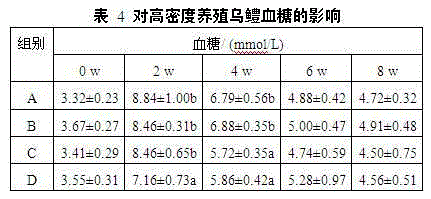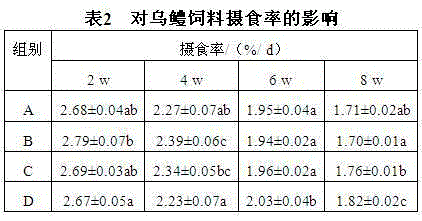Application of gamma-aminobutyric acid serving as snakehead feed additive for resisting ammonia nitrogen stress
A technology of aminobutyric acid and anti-ammonia nitrogen, applied in animal feed, animal feed, application, etc., can solve problems such as decreased disease resistance, reduced yield, and impact on large-scale breeding of snakeheads
- Summary
- Abstract
- Description
- Claims
- Application Information
AI Technical Summary
Problems solved by technology
Method used
Image
Examples
Embodiment 1
[0014] Embodiment 1 snakehead compound feed
[0015] Snakehead compound feed (A), by weight:
[0016] Domestic fish meal 45.50, aspartic acid 0.35, fish oil 1.28, peanut oil 1.48, corn 6.50, soybean meal 8.00, cotton meal 6.60, rapeseed meal 5.80, peanut meal 3.50, vitamin premix 0.95, wheat bran 14.50, subflour 28.50, bentonite 2.55 , alginate 0.50, mineral salt premix 1.80;
[0017] Snakehead compound feed (B), by weight:
[0018] Domestic fish meal 43.50, aspartic acid 0.37, fish oil 1.45, peanut oil 1.79, corn 6.50, soybean meal 8.00, cotton meal 8.60, rapeseed meal 10.80, peanut meal 6.50, vitamin premix 0.95, wheat bran 10.50, subflour 24.50, bentonite 2.55 , alginate 0.50, mineral salt premix 1.80;
[0019] Snakehead compound feed combination (C), by weight:
[0020] Domestic fish meal 45.50, aspartic acid 0.35, fish oil 1.28, peanut oil 1.48, corn 6.50, soybean meal 8.00, cotton meal 6.60, rapeseed meal 5.80, peanut meal 3.50, vitamin premix 0.95, wheat bran 14.50,...
Embodiment 2
[0025] GABA was purchased from Zhejiang Yiwan Biotechnology Co., Ltd. (content 99%). 80g / L high-density cultured snakehead, using the above-mentioned four feeds A, B, C, and D for feeding.
[0026] The breeding experiment was carried out in a room temperature-controlled single-circulation system, and the feeding time was 8 weeks. Healthy and lively snakeheads (body mass: 26.52±0.14g) were selected and randomly assigned to 12 aquariums. They were randomly divided into A, B, C, and D a total of 4 groups, each with 3 repetitions. Feed twice a day (09:00, 16:00), the daily feeding rate is 2.5-4.0% of the body weight. During the test, the water temperature was 23°C-30°C, the pH was 7.1±0.1, the dissolved oxygen was greater than 5.0mg / L, and the ammonia nitrogen was 1.0mg / L.
[0027] Feed 0, 2, 4, 6 and 8w, take samples, and calculate the average weight gain rate, growth dispersion, feed intake rate and protein efficiency.
[0028]
[0029]
Embodiment 3
[0031] After the end of the experiment, food was fasted for 24 hours, the fish were anesthetized, blood was collected from the tail vein, and serum was prepared by centrifugation at 4000r / min at 4°C for 10 minutes. The test fish that had been blooded were dissected immediately, and the hepatopancreas, head kidney and spleen were taken out. All the above operations were carried out on ice, and all samples were stored in a -80°C refrigerator for future use. Serum and tissue total protein (TP), albumin (ALB), urea (UREA), glucose (GLUC), aspartate aminotransferase (AST), and alanine aminotransferase (ALT) were measured.
[0032]
PUM
 Login to View More
Login to View More Abstract
Description
Claims
Application Information
 Login to View More
Login to View More - R&D
- Intellectual Property
- Life Sciences
- Materials
- Tech Scout
- Unparalleled Data Quality
- Higher Quality Content
- 60% Fewer Hallucinations
Browse by: Latest US Patents, China's latest patents, Technical Efficacy Thesaurus, Application Domain, Technology Topic, Popular Technical Reports.
© 2025 PatSnap. All rights reserved.Legal|Privacy policy|Modern Slavery Act Transparency Statement|Sitemap|About US| Contact US: help@patsnap.com



